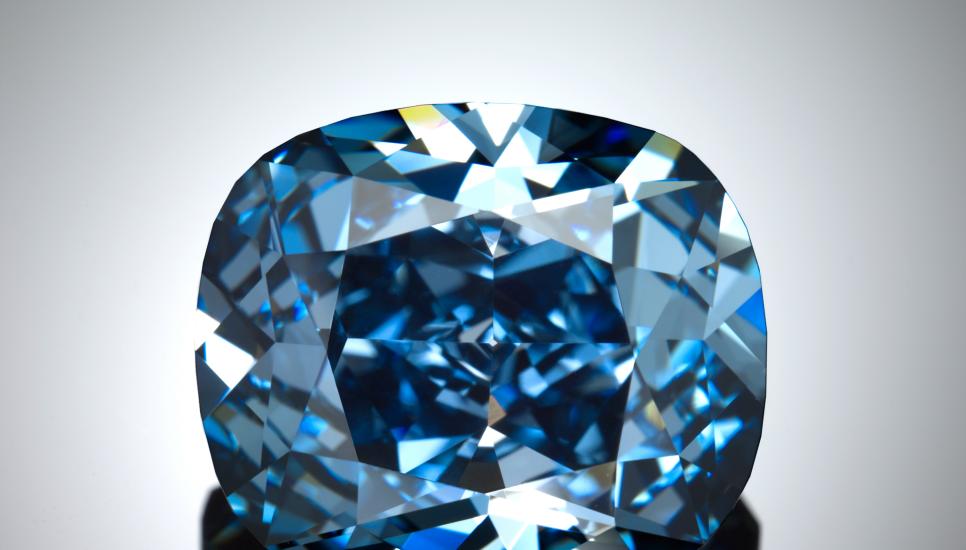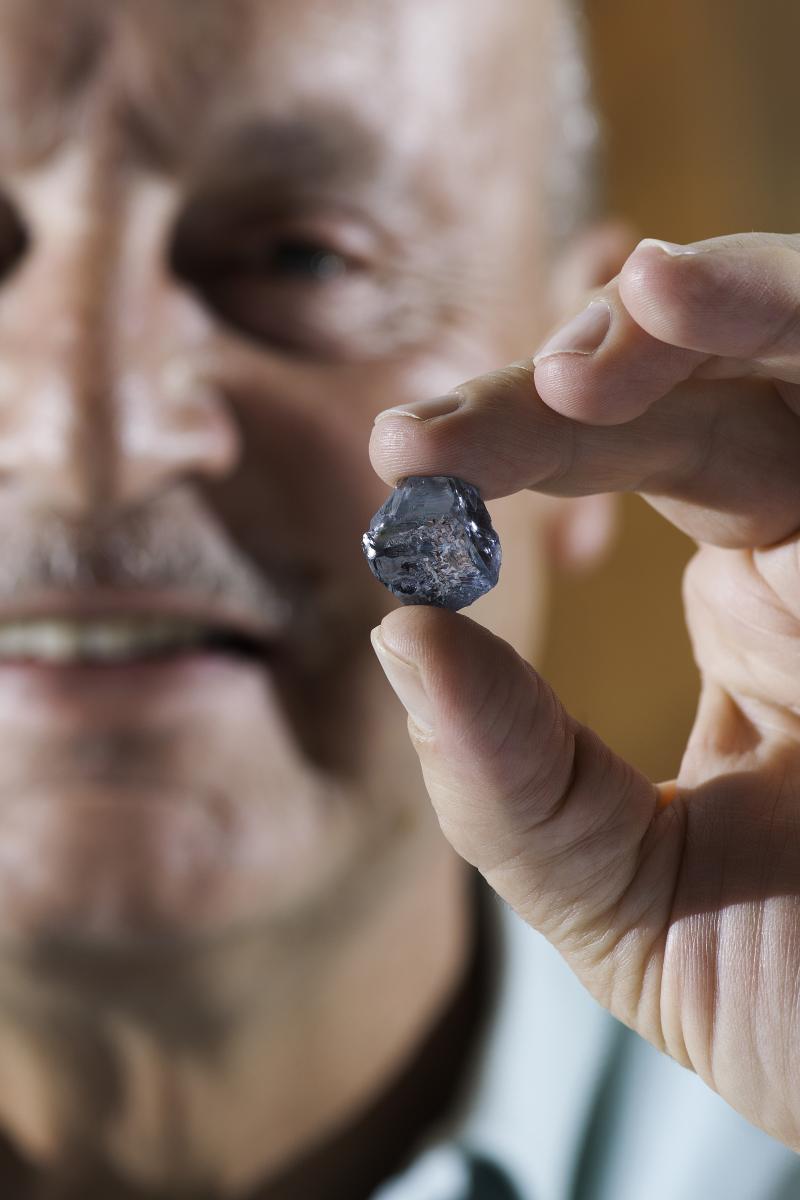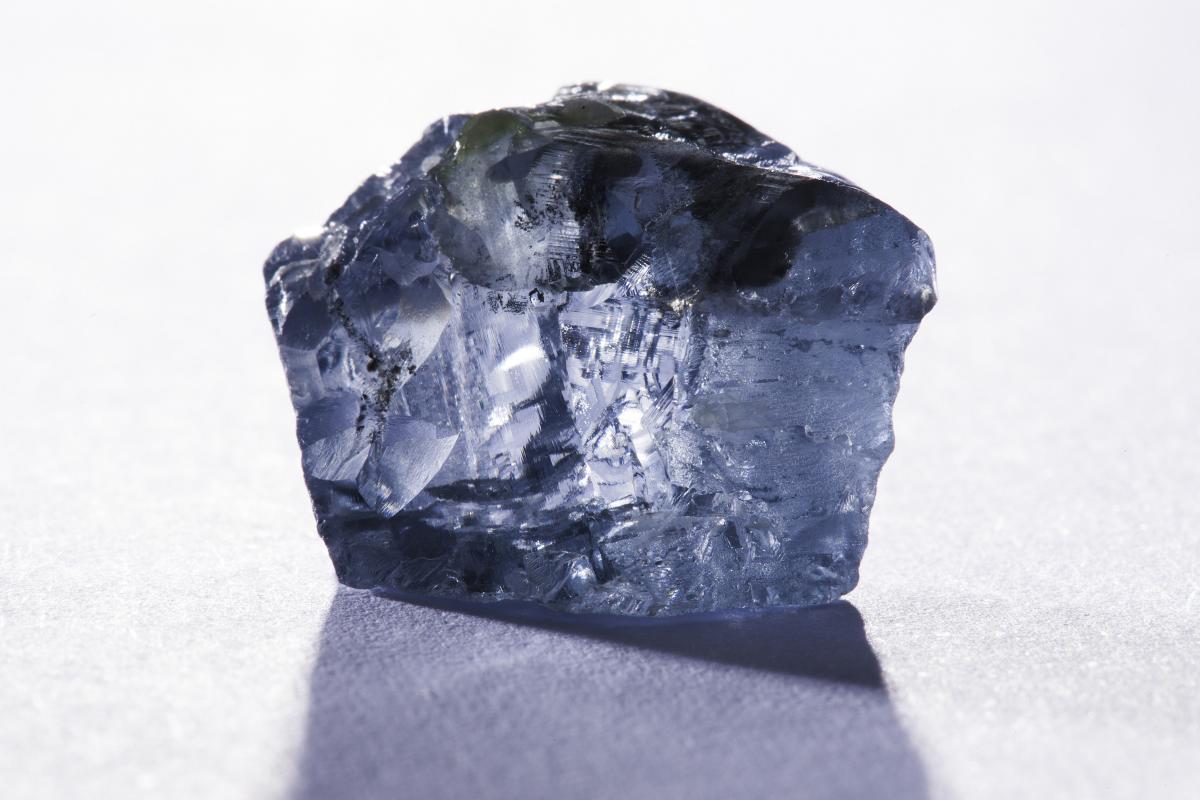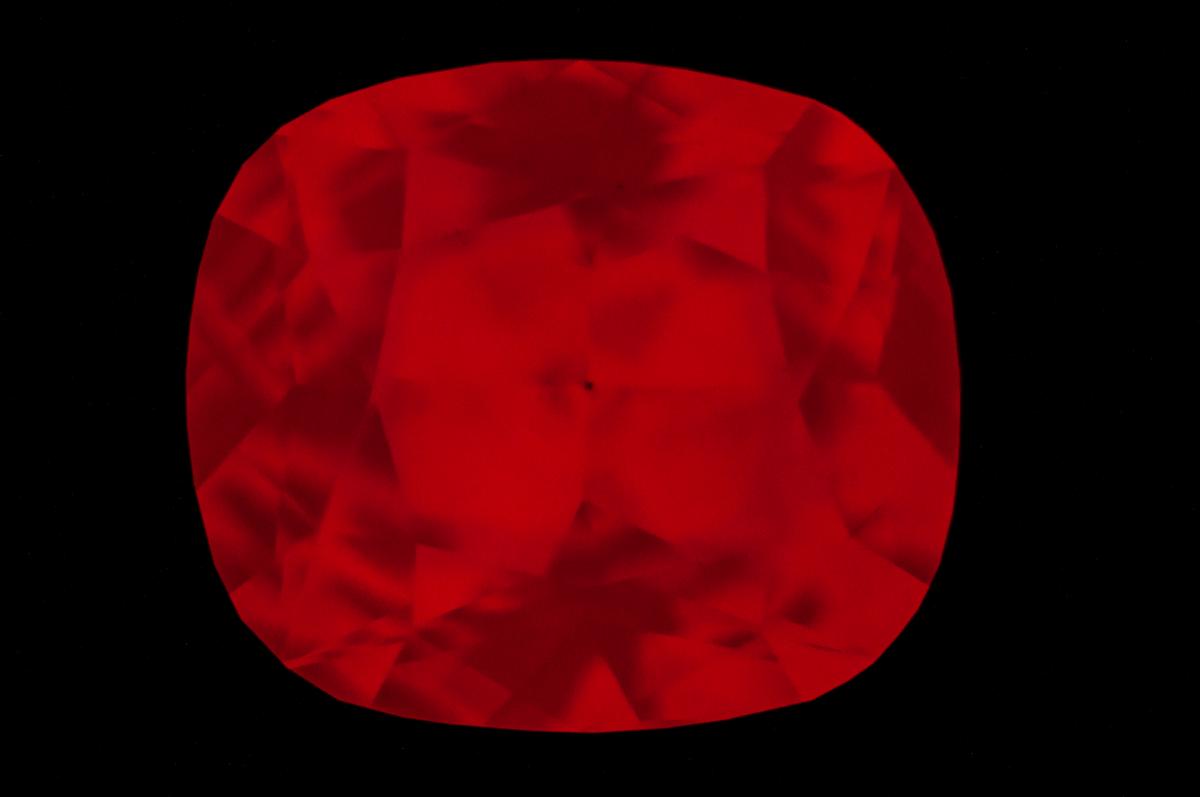Sponsored feature: The Tale of the Blue Moon Diamond

It's like a fairy tale, but the story of the Blue Moon Diamond is true. In January of 2014, an extraordinary rock created approximately one billion years ago, in the depths of the earth was released from its long sleep from a half mile down in the darkness of the Cullinan Mine in South Africa.
For one hundred years, the mine has been yielding some of the most exceptional diamonds of all the world's mines, including some of the most historical diamonds such as the Cullinan Diamond, part of the Crown Jewels of Great Britain and the Golden Jubilee Diamond, part of the Crown Jewels of Thailand. The mine is also the source of most of the natural blue diamonds that exist in the world. Even with such a track record, rarely a stone will appear that will stun the miners themselves. Greg Stephenson, diamond marketing manager for mine owner Petra Diamonds, was the first executive to view the production.
Here is how it was discovered:
“I received a call from our Head of Security to say that a blue stone had been recovered at Cullinan and that they would send me through some pictures. When I saw the initial photos I knew that the stone was exceptional but of course the proof is always in the pudding. The stone was sent to me immediately in Johannesburg and I received it the same day it came out of the ground. I opened the canister in which it was shipped and it fell on to my work pad. I sat there for about a minute just looking at it on my white pad – no light, no loupe – just awe struck. The colour, the tone, the saturation – it was magnificent. In my seven years with Petra this surpassed the previous blue stones that we had mined. We had of course produced several other beautiful blues including the speculative 39 carat that sold for $ 8.8 million and the stone that we manufactured which produced the Star of Josephine but this was more than a cut above. When I began to loupe the stone it was even more extraordinary. It was as though it had been dropped in a bottle of old blue ink – extraordinary saturation with no hint of zoning and definitely no modifying colours. I spent the rest of the day looking at it and chatting to my CEO.
We subsequently mined the 122 carat fancy blue a few months later and that too was an extraordinary piece – although far more complicated. What worries me is that I may never see a stone like the Blue Moon again. I have been in the diamond industry for 25 years and it was, without a shadow of a doubt, the most beautiful rough diamond I have ever seen.”
Greg also had no doubt that this stone would yield the highest price per carat ever for a rough diamond. No matter how spectacular a rough diamond may be, the cutting process will be a tremendous risk because the stone may shatter as it is fashioned or the color may turn out to be unfavorable and undesirable. It is not uncommon for these risks ending in failure. What lies inside the skin of the stone is a role of the dice.
Cora International took the gamble at a potent and record-breaking $870,000 per carat or about $26 million. As Suzette Gomes, the CEO of Cora International relates:
 “When the rough diamond arrived at our New York headquarters, I was amazed at the color and saw the potential but didn't realize at that moment how extraordinary the finished stone would be. I also didn't anticipate the emotional roller coaster of the process, sleepless nights and restless days, and constant decisions to adapt to complications that were guided by the stone. It was four stress filled months, with 30 plastic models to practice shapes; and then taking the last few strokes upon the cutting wheel to make it flawless, ultimately surpassing our expectations with a blue color that barely exists in any other blue diamond. It is most charming and magnificent blue diamond I have ever seen in my career and it was such an honor to be involved in the opportunity to bring it to life. I feel so happy that we have been able to share it with the public in the Natural History Museum of Los Angeles. While we are the custodian of such an extraordinary diamond, we are eager to share it publicly so it is not lost to history as it is certainly one of nature's most beautiful objects.”
“When the rough diamond arrived at our New York headquarters, I was amazed at the color and saw the potential but didn't realize at that moment how extraordinary the finished stone would be. I also didn't anticipate the emotional roller coaster of the process, sleepless nights and restless days, and constant decisions to adapt to complications that were guided by the stone. It was four stress filled months, with 30 plastic models to practice shapes; and then taking the last few strokes upon the cutting wheel to make it flawless, ultimately surpassing our expectations with a blue color that barely exists in any other blue diamond. It is most charming and magnificent blue diamond I have ever seen in my career and it was such an honor to be involved in the opportunity to bring it to life. I feel so happy that we have been able to share it with the public in the Natural History Museum of Los Angeles. While we are the custodian of such an extraordinary diamond, we are eager to share it publicly so it is not lost to history as it is certainly one of nature's most beautiful objects.”
During my visits with Suzette as a confidant in the four month transformation of the stone, as the color inside was exposed, it almost seemed surreal. Suzette was aware that I had worked closely with the Smithsonian and Jeffrey Post on scientific research of blue diamonds and she graciously agreed to allow the Smithsonian to add to their data by studying the secrets of the stone. Jeff was enthusiastic about the opportunity and he arranged for his team, geologist Eloise Gaillou, now mineral and gem curator at Natural History Museum of Los Angeles County, and Dr James Butler, research associate at the Smithsonian Institution, formerly at the U.S. Navy Research Lab.
One of the ironies of this event is that the Blue Moon was purposely designed to mimic the shape of the Hope Diamond. So we joked about it being the baby Hope. Suzette and I watched as Jeff and Eloise opened the box in the Smithsonian research lab. Jeff later shared his special day and revelations: “The rich blue color was immediately obvious, and I loved the fact that it looked like a mini-Hope. Over the past several years we measured phosphorescence spectra from perhaps 100 blue diamonds, but in most cases we did not have locality information for the stones. For those that we did, we observed the red phosphorescence only from stones that had an Indian origin, and those from the Cullinan mine typically showed a blue-green phosphorescence. It was, therefore, significant that the Blue Moon, which we know was found in the Cullinan Mine, showed a strong red phosphorescence. So, yes it was a surprise. It was a thrill to work with this beautiful stone, especially as we were able to follow it from the rough through the cutting process. The nature of its phosphorescence suggests that the particular properties of a given blue diamond likely represent a range for a given locality, rather than a specific geologic origin.”
Museums generally set exhibitions based on a long-term schedule, years in advance. But to be offered an opportunity to exhibit a stonelike this, a public debut, was the chance of a lifetime if it were available. Other extraordinary diamonds rarely are in the public domain because their ownership is mostly secret. They do not see the light of day. It did not take much convincing to get Suzette to feel comfortable with a public exhibition if it could be part of revealing the birth of a special stone. What could be literally described as spontaneous in the museum world. Eloise was able to pull the strings to get The Blue Moon to make its premier in Los Angeles. From the moment the package was opened in the Smithsonian, it was clear to Eloise this stone had surpassed her expectations. Eloise explains:
“I actually recorded on video when Jeff opened the paper in which the Blue Moon diamond was hiding. My reaction was quite a shock 'oh, wow'!!! , it is really blue! I guess the 'It is really blue' was my first thought, as most of the diamonds I have seen before were much smaller with a lighter color saturation, or bigger (like the Hope and Wittlesbach) and therefore deeper in color. So, the first thing that really struck me was this intense ocean blue color. Then, it was the cut, and how “alive” the stone was. It is indeed important to have a big diamond, but what good does it do if the cut doesn't give the stone all of its potential? It was clear that the master cutter mostly took into account the aesthetic of the stone before considering weight loss. Also, I couldn't help to think about the Hope diamond when I saw the cut of the Blue Moon, of course. On the white background of the paper, the diamond looked stunning, but when I put it on my hand, it is when the diamond looked the best. After all, a gemstone is supposed to be worn in the first place, no? Then, something I was not expecting happened: following my theory, most blue diamonds coming from South Africa should phosphoresce of a short dim bluish glow. To my biggest surprise, the Blue Moon glowed red when we turned the UV lamp off. My theory vanished with the fading red glow of the Blue Moon! Another important characteristic was the strain the diamond showed under cross polarizers. It shows that the diamond underwent some high stress in the Earth Mantle, and this stress is sometimes very well observable. The Blue Moon showed the typical 'tatami pattern' (strain striations in two directions) typical of type II diamonds.
 Getting the chance to have an exceptional stone on exhibit is rare. Yes, a curator has the chance to see some phenomenal minerals and gems in the market. We often see very spectacular gems and jewelry pieces selling for a lot of money at public auctions. Now, when one of these celebrity stones gets offered to a museum for a temporary exhibit, it is quite special. At the Natural History Museum of Los Angeles County, we have the chance as we have display cases reserved for such exceptional opportunities, and we can have a fast turnaround at being able to put something exciting and rare out on exhibit for the public to enjoy.
Getting the chance to have an exceptional stone on exhibit is rare. Yes, a curator has the chance to see some phenomenal minerals and gems in the market. We often see very spectacular gems and jewelry pieces selling for a lot of money at public auctions. Now, when one of these celebrity stones gets offered to a museum for a temporary exhibit, it is quite special. At the Natural History Museum of Los Angeles County, we have the chance as we have display cases reserved for such exceptional opportunities, and we can have a fast turnaround at being able to put something exciting and rare out on exhibit for the public to enjoy.
Back in January 2014, I followed the discovery of the 29.6-carat blue rough with great attention. A blue diamond of this size and color is extremely rare, and not seen in a very long time. I was stunned by this discovery. We even shared the special find on the museum's social media, without even thinking that the stone could eventually come as a special guest to our museum. Again, we followed with great attention when Cora International purchased the stone. At this point, we thought it would be cut, and disappear in private collection, without any chance to have seen it or touch it.
Thanks to Alan Bronstein from Aurora Gems, a longtime supporter of museums (Aurora Gems has two collections of colored diamonds on display in two museums: the Natural History Museum in London, and our own Natural History Museum of Los Angeles County), I entered in contact with Suzette Gomes, CEO of Cora International. We began talking about a possibility to get the diamond out on display here. At the time we began discussing, the blue diamond was still in its uncut form, and no name has been given to it yet. At this point, we were just betting on its exceptional potential, Suzette and I were seeing that the stone could be a major attraction to our museum. I saw an unbelievable opportunity to show our public something rare and exciting they had probably heard about in the news. Also, we created an opportunity not only to exhibit an extraordinary diamond, but also to educate the public about the physics and the geology behind diamonds. I have been studying those two aspects of diamond for almost 10 years now, and was excited to get the chance to get other people excited about it.
Suzette Gomes and Cora International gave the Natural History Museum of Los Angeles County the opportunity to be the first (and maybe the last?) venue for this blue diamond. And we took it! As you can imagine, I followed with great attention the cutting process of the stone, and its naming process, The Blue Moon. Here it was, a historic stone was born. All of this time talking about it, but I never saw it in person until I went to conduct scientific experiments on it at the Smithsonian, in August 2014. When Jeffrey Post unveiled the Blue Moon from its wrapping paper, I then knew that it would conquer the heart of all of our visitors, and it would be a main attraction to our museum. And I was right.
I hope many people will come and see the Blue Moon diamond before 6th January 2015. They will have a once in a lifetime opportunity to experience a marvel of nature, something words or a picture cannot do justice for. As I was saying, the cut of the Blue Moon makes it look “alive”, and it's only when one looks at it and moves around it that it's mystery will be revealed.”
There are very few photographers who can capture the true essence of a gem's personality. One of them is Tino Hammid, who over the last 35 years has been photographing gems for books, Christie's jewelry catalogs, and some of the most iconic and historic gems in the world.Tino's most noted shot being his classic photo of the Hope Diamond for the Smithsonian, here Tino describes shooting the Blue Moon:
“I got the call from Suzette asking if I was available to photograph the Blue Moon diamond. Having photographed thousands of pieces for Christie's catalogs,
I have seen my fair share of exceptional stones and jewelry in my lifetime. This was another job. When the stone arrived in Los Angeles at the Natural History Museum, and Eloise handed it to me to remove from the parcel paper, I thought I could see the blue color through the protective cloth. Then as I gently opened the wrapping, it was a shock to my anticipation. My first impression was that it so reminded me of the Hope Diamond which I had photographed for the Smithsonian but it had more brilliance and the color was brighter though still like staring into the deepest ocean blue. While the Hope is four times as large, Blue Moon is no slacker at 12 carats, and it had a presence beyond what I had experienced before in a color diamond. Colored diamonds are by far the most challenging of all precious stones to photograph accurately because of their brilliance and the reflection of light coming off the facets. The technical skill in positioning the facets of this stone to reveal the sea of blue inside the stone made my job even more challenging because the stone had to be positioned to reduce the surface reflections while allowing all the blue reflections bouncing around inside the stone to be captured. So this was more of a challenge than I ever expected and required repositioning the stone and the light sources over and over again to gain the quintessential shot that would do justice to the rare blue coming from its body.
 Although it took hundreds of shots to find the perfect angles and position, this was probably one of the most exciting photo sessions in my career. When I finally captured the shot I wanted, Eloise said we now have to photograph the stone as it phosphoresces red. This is an extremely difficult phenomenon to capture, especially because it is so unique in nature. On top of that the red reaction begins to fade as soon as the ultraviolet light source is removed. But with constant effort and experimentation with multiple procedures, we were able to capture the elusive phenomena at the height of its glow and watched as it quickly dissipated back to its otherworldly blue color. It was so reminiscent of the day 35 years ago when I had the honor to shoot the Hope Diamond. I have to say this was one of the most enjoyable, challenging and satisfying photo session of my career."
Although it took hundreds of shots to find the perfect angles and position, this was probably one of the most exciting photo sessions in my career. When I finally captured the shot I wanted, Eloise said we now have to photograph the stone as it phosphoresces red. This is an extremely difficult phenomenon to capture, especially because it is so unique in nature. On top of that the red reaction begins to fade as soon as the ultraviolet light source is removed. But with constant effort and experimentation with multiple procedures, we were able to capture the elusive phenomena at the height of its glow and watched as it quickly dissipated back to its otherworldly blue color. It was so reminiscent of the day 35 years ago when I had the honor to shoot the Hope Diamond. I have to say this was one of the most enjoyable, challenging and satisfying photo session of my career."
It is incredibly fortunate that all the stars were aligned for finding such an extremely rare creation, to the breathtaking color and hypnotic gem it has become, and the chance for scientific research and a public exhibition to highlight its existence. The legend of the Blue Moon Diamond begins with this fairytale moment.






